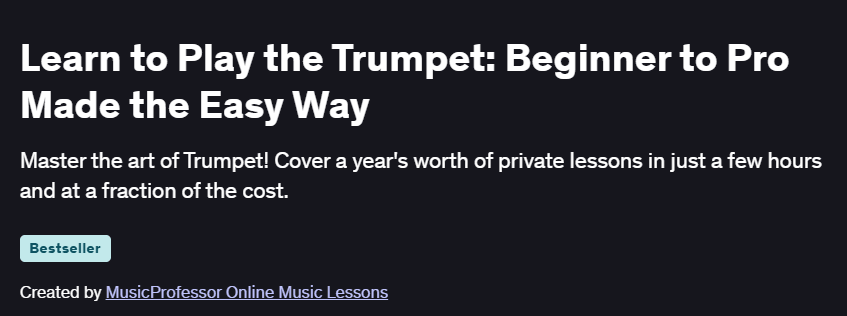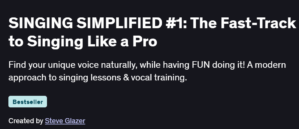What will you learn in Learn to Play the Trumpet: Beginner to Pro Made the Easy Way Course
Assemble, care for, and maintain your trumpet—including cleaning, lubrication, and mouthpiece fitting.
Develop a clear, centered tone through correct embouchure, air support, and posture.
Read standard music notation and map notes on the staff to trumpet fingerings across all three valves.
Play a variety of simple tunes—from folk melodies to basic lead‐sheet lines—following step-by-step guidance.
Master major scales and essential technical exercises to build dexterity, range, and confidence.
Program Overview
Module 1: Assembly & Maintenance
⏳ 30 minutes
Topics: Trumpet parts and assembly; cleaning slides and valves; oiling techniques
Hands-on: Disassemble your trumpet, perform a basic cleaning routine, and reassemble it correctly
Module 2: Embouchure & Tone Production
⏳ 45 minutes
Topics: Lip and jaw positioning; diaphragm breathing exercises; producing a stable buzz
Hands-on: Practice long-tone exercises and mouthpiece buzzing drills to develop a warm, consistent sound
Module 3: Music Notation & Fingering Charts
⏳ 45 minutes
Topics: Note values, key signatures, and reading treble clef notation for trumpet
Hands-on: Play written examples using animated fingering charts to reinforce staff-to-valve coordination
Module 4: Melodies & Repertoire
⏳ 1 hour
Topics: Step-by-step learning of familiar tunes (e.g., “Hot Cross Buns,” “Ode to Joy”) and simple jazz licks
Hands-on: Perform each melody along with backing tracks, focusing on intonation and rhythmic stability
Module 5: Scales & Technique Exercises
⏳ 30 minutes
Topics: Major scales in common keys, arpeggio drills, lip slurs, and valve-transition exercises
Hands-on: Run through scale and slur exercises to build flexibility, accuracy, and smooth valve changes
Module 6: Practice Strategies & Troubleshooting
⏳ 30 minutes
Topics: Effective warm-ups, practice routines, and common beginner pitfalls (e.g., squeaks, fatigue)
Hands-on: Apply targeted fixes—adjusting mouthpiece placement, modifying breath support—to resolve tone issues
Get certificate
Job Outlook
Private Trumpet Teachers: $35–$60 per hour, with demand in schools, studios, and online platforms.
Session & Freelance Work: $25–$45 per hour for studio sessions, wedding/event gigs, and pit orchestras.
Orchestral Positions: Regional ensemble salaries range $25k–$50k annually; top orchestras pay $60k–$100k.
Strong sight-reading ability and range development open doors in jazz bands, pit orchestras, and recording projects.
Specification: Learn to Play the Trumpet: Beginner to Pro Made the Easy Way Course
|
FAQs
- You’ll need a functioning standard B-flat trumpet (or equivalent) to follow the lessons effectively.
- A separate mouthpiece is required; the course expects you have one dedicated and correctly sized for your instrument.
- Basic accessories like valve oil, a cleaning cloth, tuning slide grease and a metronome/tuner will help your practice but aren’t strictly mandatory.
- Ensure your trumpet is in playable condition: valves move freely, slides aren’t stuck—otherwise you’ll spend more time troubleshooting than learning.
- If you don’t currently own a trumpet, consider renting one initially; the course assumes you’ll be able to pick up practical playing early on.
- The course contains “over 140 video lessons” and covers what might be a year of private lessons in a compressed form.
- For meaningful progress, aim for 30–45 minutes of focused practice at least 3–4 times a week, rather than one long session.
- Daily short warm-ups (10-15 minutes) help develop embouchure, posture and breath control, which are foundational in the early modules.
- As you move into melody, scale and song playing, you may need longer sessions (60 minutes) once or twice a week to consolidate.
- Progress will also depend on how much prior musical experience you have; complete beginners may need extra time to internalise music-reading and technique.
- Yes — the course modules explicitly include how to read and interpret music notation as part of the learning outcomes.
- The course emphasises technical fundamentals (posture, embouchure, instrument care), which build your capacity to play with accuracy.
- Hearing and ear-training by playing familiar melodies is included (“dozens of popular melodies and songs”).
- That said, if your goal is advanced improvisation by ear (e.g., jazz solos), you may need supplementary resources beyond this course, which focuses primarily on foundational technique and notation.
- Expect that the ability to play by ear will grow over time, but the course is structured more around structured practice (scales, songs) rather than freeform ear training.
- By the end, you should be able to assemble and maintain your trumpet, form a correct embouchure, play major scales and many melody lines with confidence.
- You’ll also be comfortable reading standard music notation for trumpet parts and understand essential musicianship elements (e.g., rhythm, pulse).
- You should be able to play numerous familiar songs or parts thereof, and respond to common technical challenges (e.g., tone production, articulation).
- However, achieving “professional-level soloist” mastery (e.g., in orchestras or jazz solos) will require additional practice, possibly advanced lessons or ensemble experience.
- Your rate of achievement depends heavily on consistency, instrument condition, and how much you practise beyond the course videos.
- If you’ve taken a few beginner lessons and have some familiarity with the trumpet, the course could still be valuable by filling in gaps (e.g., embouchure refinement, scale work, song practice).
- The modular structure means you can skip parts you’re comfortable with and focus on areas you want to improve (e.g., joining melodies or theory).
- If you’re already at an intermediate level (comfortable with all major scales, confident playing various songs, good embouchure), the course may cover familiar ground and you might progress quickly.
- You should review the curriculum topics (from module listings) to ensure the content still advances you, rather than simply repeating what you already know.
- Consider pairing the course with an instructor or peer ensemble if you want live feedback or more advanced performance opportunities beyond the solo practice videos.





